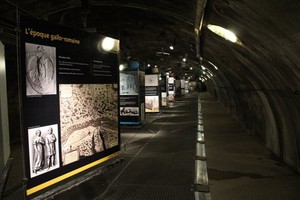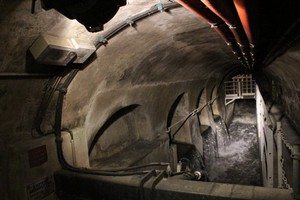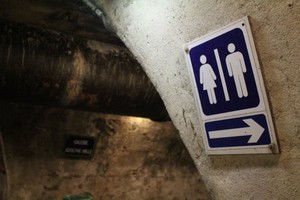Sewer Museum

- SUBSCRIBE
- ALREADY SUBSCRIBED?
BECOME A BONJOUR PARIS MEMBER
Gain full access to our collection of over 5,000 articles and bring the City of Light into your life. Just 60 USD per year.
Find out why you should become a member here.
Sign in
Fill in your credentials below.
 Do not eat.
Do not eat.
Do not bend over the manrope.
Wash your hands when you exit.
These are rules to be taken seriously when descending into the sewers of Paris.
Just a three minute walk from the iconic iron lattice of the Eiffel Tower, lurks an attraction of a very different kind.
While scores of people clamor to see the panorama of Paris from up high, others are discovering a quirky underground museum with a unique view, and indeed smell, of ‘The City of Light’.
A perfect escape from the rain or heat, ‘The Paris Sewer Museum’ or ‘Le Musée des Égouts de Paris’, holds an extensive showcase and history of what happens after you flush in cosmopolitan France.
Running tours year-round, this working museum opens its pungent doors to the public from Sunday to Wednesday, and at a price that’s rivals that of your morning coffee (4.30€ general admission).
Those with a particularly sensitive schnoz may want to think twice about taking lunch before their visit, as it does whiff a bit, but nothing worse than your local kindergarten.
It is one of the lesser-known museums of Paris, hidden along Quai d’Orsay under a small unobtrusive booth, near the Pont de l’Alma.
 Dropping down a dark spiral staircase and into dimly-lit arched walkways, the hum of gushing water rushes overhead through wastewater pipes, and in parts, beneath your feet through grated mesh.
Dropping down a dark spiral staircase and into dimly-lit arched walkways, the hum of gushing water rushes overhead through wastewater pipes, and in parts, beneath your feet through grated mesh.
Interestingly, some recognizable street signs may appear along the tour, with the wastewater tunnels designed parallel to the Parisian roads above.
There are also a number of curious displays to interest the thralls of visiting school groups, from taxidermed rats to objects found in the sewers, including a few 18th Century swords.
But tourists are also no stranger to the sewers, with tours dating right back to the 1880s, which were previously run by cables cars just near Le Bastille.
The museum offers a retrospective look at the wastewater systems used in Paris, starting from the middle ages when waste was thrown onto the streets, which unthinkably, would then filter back into the River Seine – a source of drinking water.
Thankfully, this rotten system was much improved by the later kings of France and in the mid-1880s by engineer Eugène Belgrand, who developed the current system and much of the machinery still used today.
 One of the more intriguing displays is a huge black a sphere, much like a giant eight ball, wedged into one wall.
One of the more intriguing displays is a huge black a sphere, much like a giant eight ball, wedged into one wall.
Sent through wastewater pipes to push ‘grit’ forward, the ‘Boules de Nettoyage’ or ‘Tidying Balls’ help avoid the nightmarish situation of pipe blockage, which was previously the solved by a man, a shovel and a tall pair of gum boots.
The sewer was first made famous through Victor Hugo’s 1862 novel, ‘Les Misérables’, and has also made mention in Gaston Leroux’s 1909 novel ‘The Phantom of the Opera’.
And to a lesser literary extent, was featured in two episodes of ‘Teenage Mutant Ninja Turtles’.
 Ironically, the sewer museum also has its own visitor toilets, which are connected to its very own gift shop for you to take away a truly unique museum souvenir.
Ironically, the sewer museum also has its own visitor toilets, which are connected to its very own gift shop for you to take away a truly unique museum souvenir.
(Timeline)
– The Middle Ages, the River Seine was a source of drinking water. Wastewater was often tossed onto the streets of Paris and thus trickled back into the Seine.
– About 1200, the first King of France, Philippe Auguste, ordered new drains for wastewater with the paving of streets.
– Under Louis XIV, there was a large ring sewer system and the Bièrve river was also used as a sewer.
– In Napoléon’s era (1804-1815) a 30km sewer network was built.
– It was not until 1850, that engineer Eugène Belgrand designed the current sewer system, and by 1894 it was made law that all wastewater was to go to the sewer.
– Since then, more than 1000km’s of new sewer has been included into the design and toward the end of 1970, it was considered one of the biggest sewerage treatment plants in Europe.
The Paris Sewer Museum
Le Musée les Égouts de Paris Métro
93 Quai d’Orsay, Paris 7th arrondissement
Open Wed – Sun 11am – 5pm (summer) 11am – 4pm (winter)
Closed Thursday and Friday
General admission: 4.39€
Métro: Alma-Marceau
More in Museum, Paris museums, Sewer Museum


